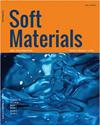通过快速后金属有机交联,将线性水性聚氨酯转变为具有提高耐水性和机械强度的交联对应物
IF 1.4
4区 材料科学
Q4 MATERIALS SCIENCE, MULTIDISCIPLINARY
引用次数: 0
摘要
共价交联可以提高水性聚氨酯(WPU)的耐水性,但交联过程会大大延长WPU的制备时间,并且由于交联的分子链在任何有机溶剂或水中都不能分散,会降低WPU乳液的长期储存稳定性。本文采用后金属-有机交联法制备了一种交联水基聚氨酯。这种post交联是相当快的,因为它是基于金属阳离子和有机阴离子之间的离子键相互作用。交联WPU乳液粒径分布窄,平均粒径小,具有优良的长期贮存稳定性。在25°C和60°C时,交联WPU的吸水率分别为6.3%和8.6%,与线性相比较,分别降低了47.9%和39.4%,表明后金属有机交联极大地提高了WPU的耐水性。与线性水基聚氨酯相比,交联水基聚氨酯的机械强度也有所提高。本文章由计算机程序翻译,如有差异,请以英文原文为准。
Turning a linear waterborne polyurethane into a crosslinked counterpart with improved water resistance and mechanical strength through a fast post metal-organic crosslinking
ABSTRACT Covalent crosslinking can improve the water resistance of waterborne polyurethanes (WPUs), but the preparation time of WPUs will be greatly extended by the crosslinking process, and the long-term storage stability of WPU emulsions will decrease because the crosslinked molecular chains cannot disperse in any organic solvents or water. In this paper, a crosslinked WPU was prepared through a post metal-organic crosslinking toward a conventional linear WPU. This post crosslinking is quite fast since it is based on the ionic bond interaction between metal cations and organic anions. The crosslinked WPU emulsion has narrow particle size distribution and small average size, giving rise to excellent long-term storage stability. Additionally, the water absorptions of the crosslinked WPU at 25°C and 60°C are 6.3% and 8.6% respectively, which decrease by 47.9% and 39.4% compared with those of the linear counterpart, indicating that the post metal-organic crosslinking highly improves the water resistance of the WPU. The mechanical strength of the crosslinked WPU also improves compared with the linear WPU.
求助全文
通过发布文献求助,成功后即可免费获取论文全文。
去求助
来源期刊

Soft Materials
工程技术-材料科学:综合
CiteScore
2.90
自引率
0.00%
发文量
21
审稿时长
2.2 months
期刊介绍:
Providing a common forum for all soft matter scientists, Soft Materials covers theory, simulation, and experimental research in this rapidly expanding and interdisciplinary field. As soft materials are often at the heart of modern technologies, soft matter science has implications and applications in many areas ranging from biology to engineering.
Unlike many journals which focus primarily on individual classes of materials or particular applications, Soft Materials draw on all physical, chemical, materials science, and biological aspects of soft matter. Featured topics include polymers, biomacromolecules, colloids, membranes, Langmuir-Blodgett films, liquid crystals, granular matter, soft interfaces, complex fluids, surfactants, gels, nanomaterials, self-organization, supramolecular science, molecular recognition, soft glasses, amphiphiles, foams, and active matter.
Truly international in scope, Soft Materials contains original research, invited reviews, in-depth technical tutorials, and book reviews.
 求助内容:
求助内容: 应助结果提醒方式:
应助结果提醒方式:


